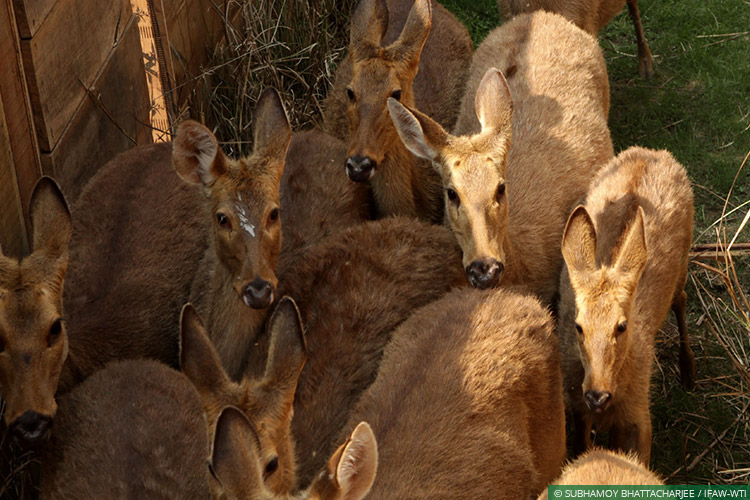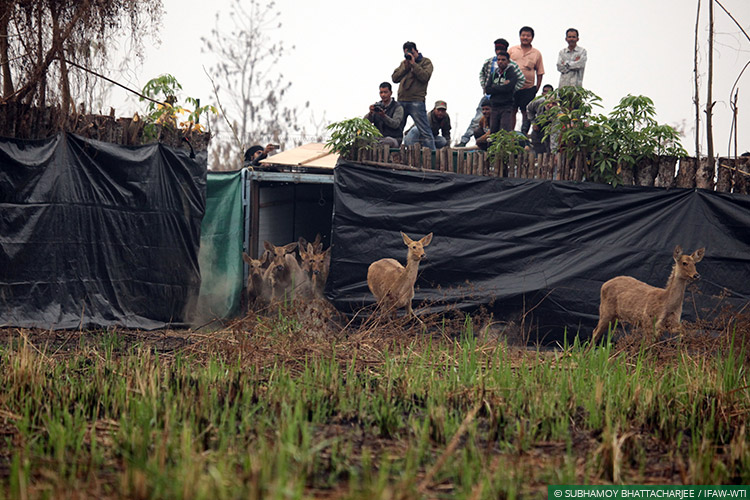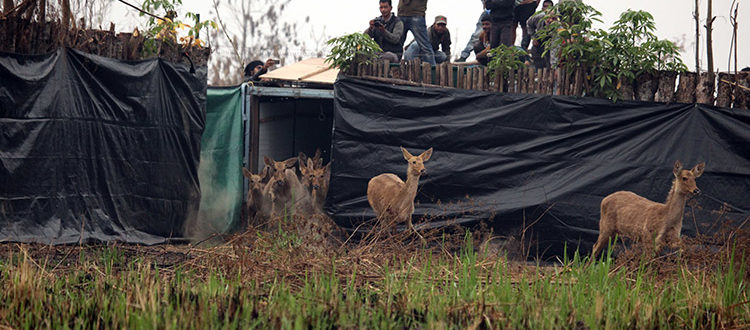Birth of Fawn Marks New Beginning for Eastern Swamp Deer Translocated Under 2nd Phase of WTI-ONGC Project
 Seventeen eastern swamp deer were herded onto customised transportation vehicles and translocated
Seventeen eastern swamp deer were herded onto customised transportation vehicles and translocated
from Kaziranga to Manas late last month
Manas National Park, March 11, 2017: Reports from the field confirm that one of the female eastern swamp deer translocated from Kaziranga National Park to Manas National Park late last month has given birth. This is the first fawn born in the pre-release boma at Manas to the second batch of deer translocated under the Eastern Swamp Deer Conservation Project. The project, led by Wildlife Trust of India (WTI), the International Fund for Animal Welfare (IFAW) and the Assam Forest Department and supported by the Oil and Natural Gas Corporation (ONGC), aims to create more viable populations of eastern swamp deer in their former distribution range, potentially saving the subspecies from extinction.
Of the three subspecies of the swamp deer in India, just about a thousand individuals of the eastern swamp deer (Rucervus duvaucelii ranjitsinhii) are left in a single population in Kaziranga. Apart from this, a tiny population also exists in Manas, the remnants of a once thriving population before civil strife hit the area and wiped out most of its wildlife. These deer are faced with a far more urgent threat than India’s rhinos, tigers or elephants. While Kaziranga is one of the best protected wildlife refuges in India, its location on the banks of the Brahmaputra River means that it faces land erosion and floods every year. In addition, biological threats such as the transmission of disease from domestic cattle living on the periphery of the national park also pose a grave threat, making the eastern swamp deer vulnerable to extinction.
Being largely limited to an isolated population, eastern swamp deer are faced with a more urgent threat of extinction than India’s rhinos, tigers or elephants
The first batch of 19 eastern swamp deer, captured in Kaziranga, were released into a predator-proof boma constructed at Manas National Park in December 2014, completing the first-ever mass capture and translocation of any large ungulate in India. The deer were released into the wild in August last year, having given birth to five fawns while still in the boma. They have successfully colonised the Kuribheel grassland in Manas.
Late last month, a second batch of 17 eastern swamp deer were captured and translocated from Solmara Beel in the central range of Kaziranga to the pre-release boma in the Bansbari range of Manas. The Mass Capture and Translocation Method (also known as the Passive Capture Method), wherein animals are captured without any physical contact or injection of chemical tranquilisers, was once again employed for the translocation. Both batches were translocated without any mortality – a notable feat considering the physiology of the animal making it prone to capture myopathy.
 The deer being released into a predator-proof boma in Manas
The deer being released into a predator-proof boma in Manas
The deer were found to be alert and stressed in the initial days following their long road journey but have gradually settled down. The project team plans to keep them within the boma for a month and, after radio-collaring and ear tagging a few of them, will release the herd into the wild. News of the newborn fawn underscores the success of the translocation exercise and suggests that this second batch of translocated deer will help establish a viable population in Manas, improving the subspecies’ genetic heterogeneity and augmenting its numbers in the long-term.









